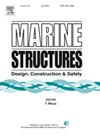Degradation mechanisms of axial compressive performance in defective unbonded flexible pipes
IF 5.1
2区 工程技术
Q1 ENGINEERING, CIVIL
引用次数: 0
Abstract
As a critical conduit connecting offshore oil and gas fields to marine platforms, the unbonded flexible pipe plays a vital role in offshore production. The tensile armor, as one of the primary load-bearing components of the flexible pipe, is crucial to the structural integrity of the pipeline system, and its failure poses a significant threat. Therefore, investigating the influence mechanisms of various defects on the mechanical properties of the tensile armor and analyzing its mechanical behavior are of great theoretical and engineering significance. A numerical simulation approach was employed to study the axial compression performance of the tensile armor in unbonded flexible pipes with defects. A five-layer finite element model of the unbonded flexible pipe under axial compression was established to examine the effects of defects in the non-metallic layer, interlayer friction coefficient, and wires fracture on the axial compression stiffness and critical buckling load. The results indicate that a decrease in the friction coefficient due to increased annular water content significantly reduces the critical buckling load, while defects in the non-metallic layer and fracture of the wires substantially decrease both axial compression stiffness and critical buckling load. These findings emphasize the necessity of monitoring annular water content and ensuring the structural integrity of each layer in engineering applications. By constructing a critical buckling load degradation model and a nonlinear axial stiffness degradation model considering defects in both non-metallic and metallic layers, as well as a degradation model for the critical buckling load and stiffness that accounts for the differences between internal and external fracture of the metal layer, this study reveals the scale-separation characteristics of interlayer mechanical transmission in unbonded flexible pipes. A key innovation of this work is the development of a dual-scale coupled axial compression degradation model. By introducing a novel degradation factor () linking non-metallic defect severity to metallic layer buckling sensitivity and a nonlinear weighted degradation term () capturing the accelerated stiffness loss due to wire fracture interactions, this model explicitly quantifies the synergistic effects between non-metallic and metallic defects, which have largely been treated in isolation previously. This provides a more comprehensive and physically grounded framework for evaluating the axial compression performance of unbonded flexible pipes with complex, co-existing defects.
缺陷无粘结柔性管轴压性能退化机理研究
无粘结柔性管作为连接海上油气田与海上平台的关键管道,在海上生产中起着至关重要的作用。拉伸护甲作为柔性管道的主要承重部件之一,对管道系统的结构完整性起着至关重要的作用,其失效将构成重大威胁。因此,研究各种缺陷对拉伸装甲力学性能的影响机理,分析其力学行为具有重要的理论和工程意义。采用数值模拟的方法研究了带缺陷的无粘结柔性管中拉伸装甲的轴压性能。建立了轴压作用下无粘结柔性管的五层有限元模型,研究了非金属层缺陷、层间摩擦系数和钢丝断裂对轴压刚度和临界屈曲载荷的影响。结果表明:环空含水量的增加导致摩擦系数的降低显著降低了临界屈曲载荷,而非金属层缺陷和导线断裂则显著降低了轴压刚度和临界屈曲载荷。这些发现强调了在工程应用中监测环空含水量和确保每层结构完整性的必要性。通过建立考虑非金属层和金属层缺陷的临界屈曲载荷退化模型和非线性轴向刚度退化模型,以及考虑金属层内外断裂差异的临界屈曲载荷和刚度退化模型,揭示了无粘结柔性管道层间机械传动的尺度分离特性。这项工作的一个关键创新是双尺度耦合轴向压缩退化模型的发展。通过引入一个新的退化因子(β(θ,L)),将非金属缺陷的严重程度与金属层的失曲灵敏度联系起来,并引入一个非线性加权退化项(ψ(nout,nint)),捕捉由于金属丝断裂相互作用导致的加速刚度损失,该模型明确量化了非金属和金属缺陷之间的协同效应,这在很大程度上是孤立的。这为评估具有复杂、共存缺陷的无粘结柔性管的轴压性能提供了一个更全面和物理基础的框架。
本文章由计算机程序翻译,如有差异,请以英文原文为准。
求助全文
约1分钟内获得全文
求助全文
来源期刊

Marine Structures
工程技术-工程:海洋
CiteScore
8.70
自引率
7.70%
发文量
157
审稿时长
6.4 months
期刊介绍:
This journal aims to provide a medium for presentation and discussion of the latest developments in research, design, fabrication and in-service experience relating to marine structures, i.e., all structures of steel, concrete, light alloy or composite construction having an interface with the sea, including ships, fixed and mobile offshore platforms, submarine and submersibles, pipelines, subsea systems for shallow and deep ocean operations and coastal structures such as piers.
 求助内容:
求助内容: 应助结果提醒方式:
应助结果提醒方式:


